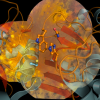Autosomal dominant neovascular inflammatory vitreoretinopathy (ADNIV) is an autoimmune disease of the eye without systemic features.
This eye-specific, inflammatory condition is characterized by the early presence of vitreous inflammation and loss of the ERG b-wave. The disease is progressive and complicated by pigmentary retinal degeneration, panuveitis, cystoid macular edema, retinal and iris neovascularization, epiretinal membrane formation, vitreous traction on the retina, vitreous hemorrhage, retinal detachment, and blindness.
The eye is an immune privileged site where the local immunological mechanisms are poorly understood. We believe understanding the cause of ADNIV will provide tremendous insight into more common eye diseases including uveitis, diabetic retinopathy, and proliferative vitreoretinopathy.
We are conducting studies into the genetics, proteomics and surgical therapy of this complex disease.
Please contact us for a consultation or to learn how you can support our research program.





